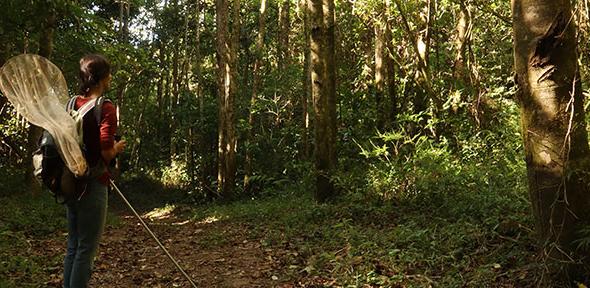In fact, tropical species’ ability to keep cool at higher air temperatures means they are more able to “thermoregulate” and keep a balanced body temperature compared to their evolutionary cousins in milder climates.
Scientists say that the strategies of butterflies from Central America to stay cool mean they could actually be better equipped to deal with global warming than previously thought.
The team behind the latest study argue that conservation researchers should be careful not to assume creatures in hotter parts of the world will suffer most under rising temperatures – rather, some butterflies in temperate regions, such as Western and central Europe, could be at greater risk.
Equipped with hand-held nets, ecologists took the temperature of over 6,800 butterflies in Panama, Austria, the Czech Republic and the UK using a tiny thermometer-like probe. They compared the butterfly’s temperature to that of the surrounding air or the vegetation it was perched on.
They found that tropical butterflies were able to maintain a lower body temperature at higher air temperatures than butterflies from milder climates. The results are published today in the journal Global Change Biology.
Researchers from the University of Cambridge and the Czech Academy of Sciences spent nine months, over the course of two trips, in the tropical lowland forests of Central Panama, working with collaborators at the Smithsonian Tropical Research Institute. Working for nine hours a day they assessed 54 species of butterflies and surrounding temperatures. They compared these measurements with those of butterflies from alpine meadows in Austria, pastures in the Czech Republic and chalk grasslands in the UK.
Researchers discovered that butterflies from different climates used specialised strategies to warm up or cool down. But physical factors – particularly wing size and shape – were key to keeping body temperature at an optimal level for butterflies across both climates studied.
Senior author Dr Andrew Bladon from the Department of Zoology, University of Cambridge, said: “We were surprised to see that it was physical differences like wing size and shape that drove a butterfly species’ ability to keep their temperature constant in both regions, rather than an inherent difference between species adapted to tropical and temperate climates. We expected to find that tropical species would be more sensitive to temperature changes, but this may not be the case.”
The team say that when it comes to butterflies’ ability to buffer against changing temperatures – and ultimately survive – bigger appears to be better. For tropical butterflies, bigger wings mean they are more mobile and can fly quicker to cooler areas. And for butterflies who live in mild climates, bigger wings allow them to warm up faster when basking in the sun, giving them the energy boost they need to fly.
“Our results have highlighted how unique these species are – they’re using different strategies to cool down or warm up,” said co-lead author Esme Ashe-Jepson, University of Cambridge. “What’s exciting is that these results suggest that physiological measures could be used to make predictions about how species might respond to climate change.”
“We showed that changes in size and wing shape are important for coping with temperature change,” said co-lead Benita Laird-Hopkins, University of South Bohemia. “For example, small butterflies, regardless of where they are from, are likely to be more impacted by climate change than big butterflies.”
While the current study suggests a note of optimism in terms of the ability of some butterfly species to live in hot temperatures, what is not known is how butterflies may cope with dramatic shifts in temperature like heatwaves, or what effect a warming climate will have on other life stages, such as caterpillars and eggs.
Bladon says more research is needed to understand how other insect groups, as well as butterflies, respond to temperature change. “The dual threats of climate and habitat change threaten to push many insects to their physiological limits. Understanding how and where this happens is crucial for designing conservation mitigation strategies, but we also need to act fast to protect and restore diverse habitats.”
“The University of Cambridge is a public collegiate research university in Cambridge, England. Founded in 1209, the University of Cambridge is the third-oldest university in continuous operation.”
Please visit the firm link to site






